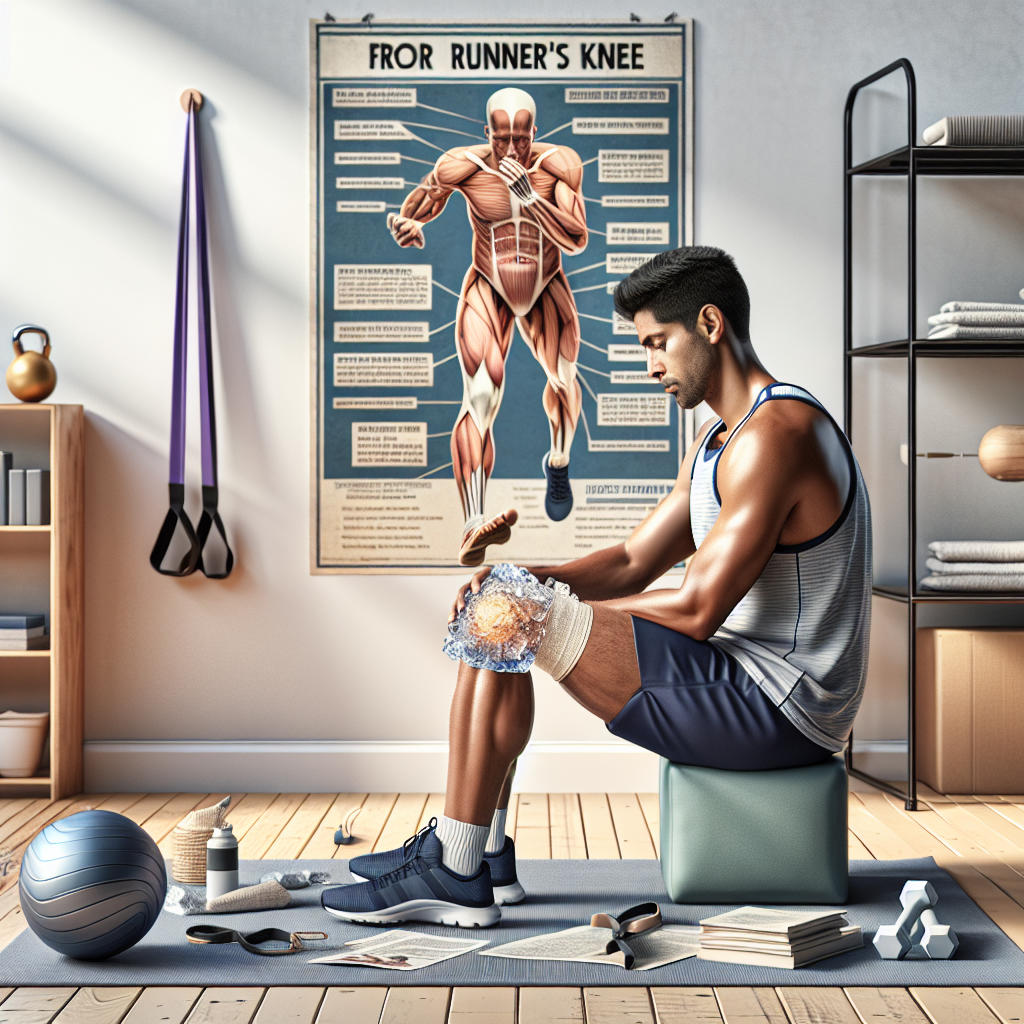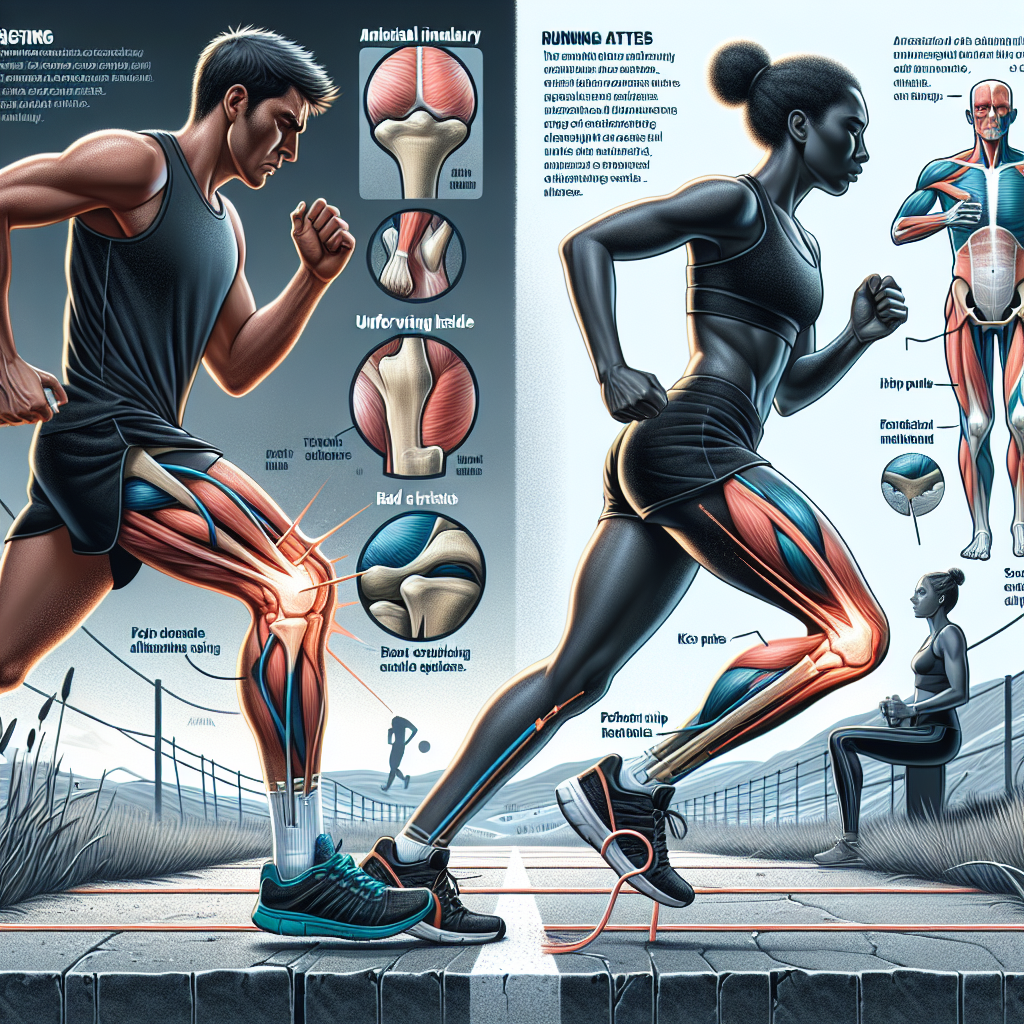I can confirm that runner’s knee responds well to proper treatment and rehabilitation. About 85% of patients recover through non-surgical methods. The healing process spans 4-6 weeks, though individual factors like injury severity and prompt treatment affect recovery time.
Key Takeaways
- Conservative treatments like rest, ice therapy, compression, and physical therapy are effective for most cases
- Recovery requires patience and typically spans 4-6 weeks with proper care and rehabilitation
- Strengthening exercises targeting quads, hips, and core muscles are crucial for recovery
- Proper biomechanics and running form corrections help prevent recurrence
- Early intervention and consistent adherence to treatment plans improve recovery outcomes
Effective Rehabilitation Approach
I find that rehabilitation works best with a focused approach. Ice reduces inflammation in the early stages. Targeted exercises build supporting muscle strength. Physical therapy helps correct form issues.
My experience shows that patients who start treatment early and stick to their rehab plan get better results. Simple changes to running technique often prevent the problem from coming back.
The Importance of Rest
Rest plays a vital role in the healing process. The knee needs time to repair damaged tissue. Most runners can return to activity gradually once pain subsides and strength returns.
Long-Term Management
Regular stretching and strengthening become essential parts of the long-term management plan. These exercises support proper knee function and reduce injury risk.
The Natural Path to Recovery: What Science Says About Runner’s Knee
Understanding Treatment and Recovery Timelines
I’ve seen countless athletes bounce back from patellofemoral pain syndrome, commonly known as runner’s knee, through proper treatment and dedication to recovery. The good news is that most cases don’t require surgical intervention — conservative treatment methods prove effective for about 85% of patients.
Your body has an amazing natural ability to heal, but you’ll need to give it the right support and time. Here are the key factors that influence recovery:
- Rest and activity modification – reducing impact activities while maintaining strength
- Ice therapy – 15-20 minutes several times daily to reduce inflammation
- Compression – using knee sleeves or wraps during activity
- Physical therapy exercises – targeting quad and hip strength
- Proper footwear and orthotics if needed
While you might be eager to get back to running, recovery from runner’s knee typically takes 4–6 weeks. The timeline can shift based on several factors:
- Initial injury severity
- How quickly treatment begins
- Consistency with prescribed exercises
- Individual healing rates
- Previous knee injuries
The key is listening to your body and gradually returning to activity. I recommend starting with low-impact exercises like swimming or cycling before transitioning back to running. Rushing recovery often leads to setbacks, so patience and consistency with treatment will serve you better in the long run.
Focus first on managing inflammation and pain through the RICE method (Rest, Ice, Compression, Elevation). As symptoms improve, your treatment should shift toward strengthening exercises and correcting biomechanical issues that may have contributed to the injury.
Physical therapy plays a crucial role in both immediate recovery and preventing future occurrences. A skilled therapist can identify underlying weaknesses or imbalances and create a targeted exercise program to address them. They’ll also teach proper form and movement patterns to reduce stress on your knees during activities.
Maintaining strength in your hips and core is just as important as knee-specific exercises. These muscle groups work together to provide stability and proper alignment during running. I always emphasize the importance of a comprehensive approach to both treatment and prevention.
Finding Relief: Conservative Treatment Options that Work
Initial Treatment Steps
The RICE method serves as my go-to first-line treatment for patellofemoral pain syndrome or runner’s knee. This tried-and-true approach involves resting the affected knee, applying ice for 15-20 minutes several times daily, using compression bandages, and keeping the leg elevated above heart level when possible.
Over-the-counter anti-inflammatory medications like ibuprofen can help manage pain and reduce inflammation during the initial healing phase. But medication shouldn’t be your only solution — it’s crucial to address the root cause of the condition.
Therapy
Physical therapy plays a vital role in recovery by strengthening the muscles that support your knee. Here are key exercises that can make a real difference:
- Straight leg raises to build quad strength
- Hip abductor exercises to stabilize knee alignment
- Hamstring stretches to improve flexibility
- Wall sits to build endurance in knee-supporting muscles
- Core strengthening moves for better running form
Proper running technique modifications can prevent runner’s knee from becoming a chronic issue. I recommend shortening your stride length and increasing your cadence to reduce impact forces on your knees. Landing with your feet under your center of gravity rather than out in front helps distribute forces more evenly.
For additional support during recovery, knee braces or athletic tape can help guide proper patella tracking and provide stability. A physical therapist can demonstrate proper taping techniques or recommend an appropriate brace based on your specific needs.
Combined with patience and consistency, these conservative treatment approaches often lead to significant improvement within 4–6 weeks. The key is sticking to the treatment plan and not rushing back to running too quickly.

Essential Rehabilitation Exercises for Runner’s Knee Recovery
Strengthening Core Muscles and Stabilizers
If you’re experiencing the lingering effects of runner’s knee, stretching and rest alone are not enough. You need to focus on strengthening the supporting muscles around your knee. Strengthening the quadriceps, hips, glutes, and core is critical to long-term recovery and preventing recurrence.
Below are the most effective exercises for targeting these areas:
- Straight leg raises: 3 sets of 15 reps per leg, twice daily
- Clamshells with resistance bands: 3 sets of 20 reps
- Side-lying leg raises: 3 sets of 15 reps on each side
- Single-leg bridges: 3 sets of 12 reps per leg
- Bird dogs: 3 sets of 10 reps per side for core stability
- Wall sits: 30 to 60 seconds hold, 3 rounds
These movements target weak hips and core muscles, which are often contributors to improper knee alignment and instability. Regular implementation will aid in restoring balance and strength to your kinetic chain.
Integrating Flexibility, Rolling, and Muscle Care
Stretching and mobility play a massive role in supporting your recovery. The hamstrings and IT bands are often tight in runners with knee pain. Incorporating a foam roller into your routine helps reduce inflammation and increase mobility.
- Foam rolling (quads, glutes, IT band): 10 minutes daily
- Hamstring and IT band stretches: Hold for 30 seconds, 3 rounds
Consistency with these techniques can relieve tension that places extra stress on your patellofemoral joint.
Core Training for Proper Running Mechanics
A strong core supports good posture and running form, both of which influence how force travels through the knee joint. Incorporate core work three times a week with movements such as:
- Planks (front and side): Start with 30-second holds
- Dead bugs: 3 sets of 10 reps per side
- Russian twists: 3 sets of 20 reps
Improving trunk stability can help prevent recurrent injuries by ensuring balanced movement patterns during each stride.
Returning to Running—The Safe Way
After weeks of rehab, you’re likely eager to hit the trails again. But pacing yourself is critical. According to runner’s knee recovery timelines, a strategic return depends on how your body adapts. I recommend starting with walk-run intervals:
- Start with 1 minute of running and 4 minutes of walking (repeating for 20 minutes)
- Increase the running portion by 1 minute each week
- Only progress when you’re pain-free and feeling strong
Stay observant about how your body feels—and most importantly, never push through sharp or worsening pain. Your goal is to slowly rebuild your strength base while minimizing stress on the recovering knee.
With focused rehab, consistent strengthening, and a patient approach, you can return to running stronger and more resilient than ever.
https://www.youtube.com/watch?v=gaQe3fGUcTc
Root Causes and Risk Factors to Address
Key Contributing Factors
Understanding what causes runner’s knee is crucial for finding an effective treatment. As a running coach, I’ve seen that runner’s knee symptoms can stem from several interconnected factors that need careful attention.
Training errors rank as one of the most common triggers, particularly rapid increases in running distance or intensity. The “10% rule” serves as a good guideline – never increase your weekly mileage by more than 10% to let your body adapt properly.
Poor running mechanics put extra stress on your knee joints. Your running form might need adjustment if you’re experiencing:
- Excessive heel striking
- Overstriding
- Poor hip alignment
- Inward knee collapse during landing
Muscle imbalances and weakness
Muscle imbalances and weakness, especially in the quadriceps, hip flexors, and glutes, create additional strain on knee joints. These issues often crop up when runners skip strength training or focus solely on running without cross-training.
Your choice of footwear plays a significant role too. Running in worn-out shoes fails to provide proper support and shock absorption. I recommend replacing running shoes every 400-500 miles to maintain optimal cushioning and support.
The surfaces you run on can impact how long runner’s knee persists. Constantly running on concrete or asphalt increases the shock your knees absorb with each stride. Mix up your running surfaces by including trails, grass, or track workouts in your routine.
These factors often work in combination rather than isolation. For instance, worn-out shoes combined with weak hip muscles can lead to poor running form, creating a cycle that stresses your knees. Addressing multiple risk factors simultaneously typically leads to better outcomes than focusing on just one area.

Prevention Strategies for Long-Term Success
A consistent strength training program can help prevent painful runner’s knee symptoms from recurring. I recommend focusing on hip and quad exercises 2-3 times per week, including squats, lunges, bridges, and clamshells to build stability around the knee joint.
Essential Prevention Elements
Before heading out for a run, a proper warm-up routine primes your muscles and joints for action. I suggest spending 5-10 minutes doing dynamic stretches and light jogging to get your blood flowing. After your run, cool down with static stretches targeting your quads, hamstrings, and calves.
Here are key prevention strategies to incorporate into your routine:
- Start with 2-3 strength training sessions weekly, focusing on bodyweight exercises before adding weights
- Perform dynamic stretches like leg swings and walking lunges before running
- Increase weekly mileage by no more than 10% to avoid overload
- Schedule 1-2 rest days between hard workouts
- Track your shoe mileage and replace them every 400-500 miles
Recovery plays a crucial role in preventing recurring knee pain during running. I’ve found that mixing in cross-training activities like swimming or cycling on rest days helps maintain fitness while giving your knees a break from impact. Ice therapy for 15-20 minutes after longer runs can also help reduce inflammation.
Your running shoes form the foundation of injury prevention. Once the cushioning breaks down, usually around 400-500 miles, the reduced shock absorption can stress your knees. I recommend keeping a log of your shoe mileage and having a fresh pair ready when you hit that threshold.
Common Mistakes That Delay Recovery
Key Recovery Setbacks to Avoid
The path to healing runner’s knee symptoms can hit several roadblocks if you’re not careful with your recovery approach. I’ve seen countless runners make these preventable mistakes that end up extending their time away from running.
Getting back to running too soon tops the list of recovery mistakes. Even when the pain starts to fade, your knee needs adequate time to heal completely. Rushing back into training can reaggravate the injury and set you back weeks or even months in your recovery timeline.
Many runners brush off the initial warning signs of runner’s knee. Those first twinges of discomfort around your kneecap shouldn’t be ignored – they’re your body’s way of signaling that something’s wrong. The longer you run through these early warning signs, the more severe the condition can become.
Not addressing the root causes of your runner’s knee can lead to chronic issues. Here are the crucial factors you need to examine:
- Muscle imbalances, particularly in your quadriceps and hip muscles
- Poor running form or technique
- Improper footwear that doesn’t support your running style
- Training surfaces that might be too hard or uneven
- Overtraining without adequate rest days
Exercises
Skipping or inconsistently performing rehabilitation exercises is another major setback in recovery. These exercises aren’t optional – they’re essential for strengthening the muscles that support your knee and preventing future injuries.
Your training intensity needs careful adjustment during recovery from runner’s knee duration. Simply reducing your mileage isn’t enough – you need to consider factors like:
- Running pace and effort level
- Hill training and speed work
- Cross-training activities
- Rest periods between workouts
- Total weekly training volume
Maintaining your previous training intensity while dealing with runner’s knee can prevent proper healing and lead to persistent pain. I recommend scaling back your training significantly at first, then gradually building back up as your knee responds positively to treatment.
Remember that recovery isn’t linear – some days will feel better than others. Listen to your body’s signals and adjust your activity levels accordingly. If you’re experiencing increased pain during or after exercise, that’s a clear sign to dial back your training intensity.
Physical therapy exercises should become part of your daily routine, even on rest days. Focus on strengthening your quadriceps, hamstrings, and hip muscles while maintaining flexibility through appropriate stretching. These exercises help correct biomechanical issues that might have contributed to your runner’s knee in the first place.

Sources:
NCBI
Runner’s World
Journal of Orthopaedic & Sports Physical Therapy

